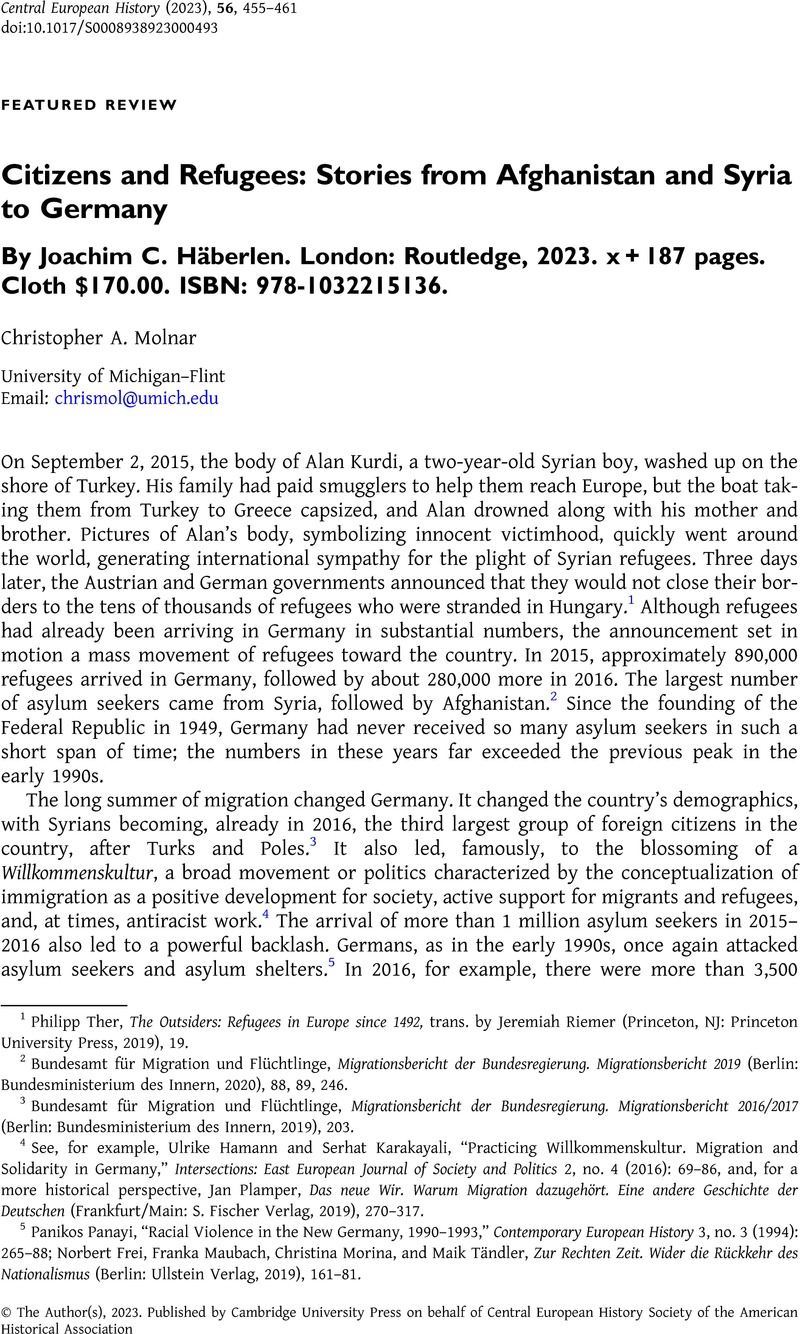No CrossRef data available.
Published online by Cambridge University Press: 08 November 2023

1 Ther, Philipp, The Outsiders: Refugees in Europe since 1492, trans. by Riemer, Jeremiah (Princeton, NJ: Princeton University Press, 2019), 19Google Scholar.
2 Bundesamt für Migration und Flüchtlinge, Migrationsbericht der Bundesregierung. Migrationsbericht 2019 (Berlin: Bundesministerium des Innern, 2020), 88, 89, 246.
3 Bundesamt für Migration und Flüchtlinge, Migrationsbericht der Bundesregierung. Migrationsbericht 2016/2017 (Berlin: Bundesministerium des Innern, 2019), 203.
4 See, for example, Hamann, Ulrike and Karakayali, Serhat, “Practicing Willkommenskultur. Migration and Solidarity in Germany,” Intersections: East European Journal of Society and Politics 2, no. 4 (2016): 69–86CrossRefGoogle Scholar, and, for a more historical perspective, Plamper, Jan, Das neue Wir. Warum Migration dazugehört. Eine andere Geschichte der Deutschen (Frankfurt/Main: S. Fischer Verlag, 2019), 270–317Google Scholar.
5 Panayi, Panikos, “Racial Violence in the New Germany, 1990–1993,” Contemporary European History 3, no. 3 (1994): 265–88CrossRefGoogle Scholar; Frei, Norbert, Maubach, Franka, Morina, Christina, and Tändler, Maik, Zur Rechten Zeit. Wider die Rückkehr des Nationalismus (Berlin: Ullstein Verlag, 2019), 161–81Google Scholar.
6 “Mehr als 3500 Angriffe auf Flüchtlinge,” Süddeutsche Zeitung, February 26, 2017 (https://www.sueddeutsche.de/politik/fremdenhass-mehr-als-3500-angriffe-auf-fluechtlinge-im-jahr-2016-1.3395560).
7 Bade, Klaus J., Ausländer-Aussiedler-Asyl. Eine Bestandsaufnahme (Munich: C. H. Beck, 1994)Google Scholar; Herbert, Ulrich, Geschichte der Ausländerpolitik in Deutschland. Saisonarbeiter, Zwangsarbeiter, Gastarbeiter, Flüchtlinge (Munich: C. H. Beck, 2001)Google Scholar.
8 The major exception is Patrice G. Poutrus, who has published numerous articles on the history of political asylum in East and West Germany and the first general history of asylum in postwar Germany; see Poutrus, Patrice G., Umkämpftes Asyl. Vom Nachkriegsdeutschland bis in die Gegenwart (Berlin: Christoph Links Verlag, 2019)Google Scholar.
9 Kiss, Rita, Aus Ungarn nach Bayern. Ungarnflüchtlinge nach Freistaat Bayern, 1956–1973 (Regensburg: Verlag Friedrich Pustet, 2022)Google Scholar.
10 Frank Bösch,“Engagement für Flüchtlinge. Die Aufnahme vietnamesischer ‘Boat People’ in der Bundesrepublik,” Zeithistorische Forschungen 14, no. 1 (2017): 13–40.
11 Ther, Philipp, Die Außenseiter. Flucht, Flüchtlinge und Integration im Modernen Europa (Berlin: Suhrkamp Verlag, 2017)Google Scholar.
12 Plamper, Das neue Wir.
13 Poutrus, Umkämpftes Asyl, 13.
14 Jonathan Spanos, Flüchtlingsaufnahme als Identitätsfrage. Der Protestantismus in den Debatten um die Gewährung von Asyl in der Bundesrepublik (1949–1993) (Göttingen: Vandenhoeck & Ruprecht, 2022); Christopher A. Molnar, Memory, Politics, and Yugoslav Migrations to Postwar Germany (Bloomington: Indiana University Press, 2018); Kiss, Aus Ungarn nach Bayern.
15 Stokes, Lauren, “The Permanent Refugee Crisis in the Federal Republic of Germany, 1949–,” Central European History 52, no. 1 (2019): 19–44CrossRefGoogle Scholar; Stokes, Lauren, “Racial Profiling on the U-Bahn: Policing the Berlin Gap in the Schönefeld Airport Refugee Crisis,” Central European History 56, no. 2 (2023): 236–54CrossRefGoogle Scholar; Molnar, Christopher A., “Greetings from the Apocalypse: Race, Migration, and Fear after German Reunification,” Central European History 54, no. 3 (2021): 491–515CrossRefGoogle Scholar. This trend is also evident in other journals. See, for example, the forum “The Refugee Crisis in Historical Perspective,” Journal of Modern European History 20, no. 1 (2020); and the special issue “Refugees Then and Now: Memory, History and Politics in the Long Twentieth Century,” Pattens of Prejudice 52, nos. 2–3 (2018).
16 Zygmunt Bauman, “The Migration Panic and Its (Mis)uses,” Social Europe, December 17, 2015 (https://www.socialeurope.eu/migration-panic-misuses).
17 Joachim C. Häberlen, Wie aus Fremden Freunde werden. Ein politisches Essay über Begegnungen mit Flüchtlingen (Berlin: Neofelis Verlag, 2018).
18 Plamper, Das neue Wir, 270–71.
19 Peter Gatrell, “Refugees—What's Wrong with History?” Journal of Refugee Studies 30, no. 2 (2017): 170–89. For a similar article that takes stock of the growth of the field and seeks to set an intellectual agenda for the field of refugee history, see Lauren Banko, Katarzyna Nowak, and Peter Gatrell, “What Is Refugee History, Now?” Journal of Global History 17, no. 1 (2022): 1–19.